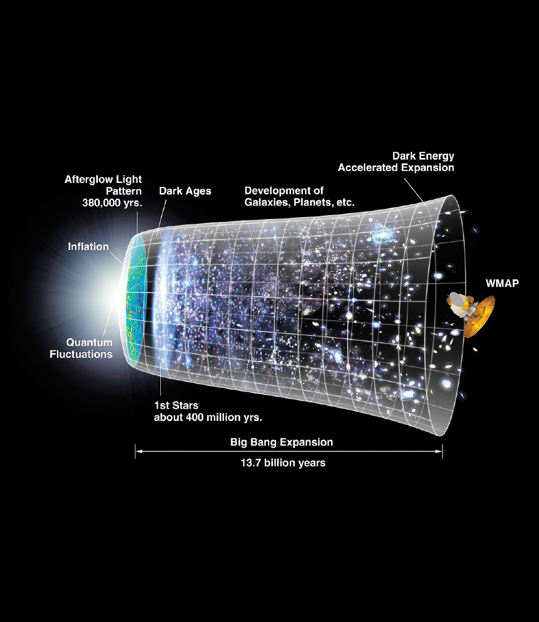2001
Age of the Universe
David T. Wilkinson (1935–2002)
The Hubble Space Telescope (HST) was essentially built to be a time machine. By gazing deeper into space, it also peers farther back in time, detecting light that was emitted by stars and galaxies many billions of years ago. Using standard candles, such as Cepheid variable stars, or certain types of supernova explosions in far-distant galaxies, astronomers have been able to use HST to refine Hubble’s Law, and to determine the rate of the expansion of the cosmos. After a decade of observations, in 2001 HST scientists announced that by turning the clock backward on their derived expansion rate, they could deduce that the Big Bang had occurred approximately 13.7 billion years ago.
Around the same time, a new space satellite was launched, designed to measure the details of the Cosmic Microwave Background radiation from the initial expansion of the early universe. Dauntingly named the Wilkinson Microwave Anisotropy Probe (WMAP) after the American cosmologist David T. Wilkinson, the satellite took high-resolution images of variations (anisotropies) in the 3-kelvins background radiation that is the remnant of the universe’s expansion following the first few hundred thousand years after the Big Bang, at the beginning of the so-called dark ages but before the birth of the first stars. Amazingly, independent of HST or other methods, the WMAP data lead to an estimate of the age of the universe of 13.7 billion years.
By combining data from HST, WMAP, and other studies, cosmologists today claim that the Big Bang happened 13.75±0.11 billion years ago—a stunning level of precision! The Big Bang frames the standard model of cosmology, with hydrogen, helium, and a few other light elements created in the Big Bang, and heavier elements—the eventual building blocks of life—subsequently created in stars and supernova explosions. Explosion, rapid inflation, deionization, reionization, slow expansion, and accelerating expansion are all now key milestones in cosmologists’ understanding of the universe.
Knowing when the Big Bang occurred raises more questions, though. Why did it occur? What was there “before” space and time were created? How will it end? Such deep questions push the boundaries of what can be studied by modern science.
SEE ALSO Big Bang (c. 13.7 Billion BCE), Recombination Era (c. 13.7 Billion BCE), First Stars (13.5 Billion BCE), Hubble’s Law (1929), Cosmic Microwave Background (1964), Hubble Space Telescope (1990), Mapping the Cosmic Microwave Background (1992), Dark Energy (1998), How Will the Universe End? (The End of Time).
A cartoon representation of the standard model of the universe from WMAP data, dating back 13.7 billion years to the Big Bang. After a rapid moment of inflation, the ensuing gradual expansion of the universe has recently begun to speed up, potentially due to the effects of dark energy.
